Top 10 Most Important Roman Inventions
The Roman Empire is considered to be one of the most influential civilizations of all time. They were technologically advanced and with their impressive engineering skills, they created some of the most important and most historically significant inventions that still impact our lives today.The Top Ten
1 Concrete
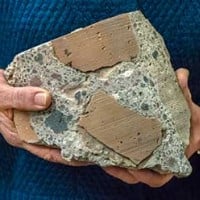 Although the ancient Romans weren't the first to create concrete, they were the first to utilize this material widely. By 200 BC, the Romans successfully implemented the use of concrete in the majority of their construction projects, greatly reinforcing all of their structures. They employed a mixture of volcanic ash, lime, and seawater to create the concrete mix, which proved to be highly durable and versatile in various architectural applications. The Romans' mastery of concrete allowed them to construct magnificent buildings, aqueducts, and bridges that still stand as a testament to their engineering ingenuity and lasting impact on construction techniques.
Although the ancient Romans weren't the first to create concrete, they were the first to utilize this material widely. By 200 BC, the Romans successfully implemented the use of concrete in the majority of their construction projects, greatly reinforcing all of their structures. They employed a mixture of volcanic ash, lime, and seawater to create the concrete mix, which proved to be highly durable and versatile in various architectural applications. The Romans' mastery of concrete allowed them to construct magnificent buildings, aqueducts, and bridges that still stand as a testament to their engineering ingenuity and lasting impact on construction techniques.
 Although the ancient Romans weren't the first to create concrete, they were the first to utilize this material widely. By 200 BC, the Romans successfully implemented the use of concrete in the majority of their construction projects, greatly reinforcing all of their structures. They employed a mixture of volcanic ash, lime, and seawater to create the concrete mix, which proved to be highly durable and versatile in various architectural applications. The Romans' mastery of concrete allowed them to construct magnificent buildings, aqueducts, and bridges that still stand as a testament to their engineering ingenuity and lasting impact on construction techniques.
Although the ancient Romans weren't the first to create concrete, they were the first to utilize this material widely. By 200 BC, the Romans successfully implemented the use of concrete in the majority of their construction projects, greatly reinforcing all of their structures. They employed a mixture of volcanic ash, lime, and seawater to create the concrete mix, which proved to be highly durable and versatile in various architectural applications. The Romans' mastery of concrete allowed them to construct magnificent buildings, aqueducts, and bridges that still stand as a testament to their engineering ingenuity and lasting impact on construction techniques. Impressive how a material that was invented thousands of years ago still manages to be stronger than most modern buildings today.
2 Sewers and Sanitation
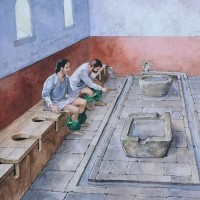 Thanks to their advanced aqueduct system, the Romans enjoyed access to fresh water within their cities, and they further developed a sewer system and implemented sanitary management to remove waste from urban areas. They connected the aqueduct to drainage pipes, allowing regular flushing with water runoff from streams. Additionally, the Romans introduced public "bathrooms" of sorts to maintain cleanliness in the streets, ensuring the proper disposal of human waste.
Thanks to their advanced aqueduct system, the Romans enjoyed access to fresh water within their cities, and they further developed a sewer system and implemented sanitary management to remove waste from urban areas. They connected the aqueduct to drainage pipes, allowing regular flushing with water runoff from streams. Additionally, the Romans introduced public "bathrooms" of sorts to maintain cleanliness in the streets, ensuring the proper disposal of human waste.
 Thanks to their advanced aqueduct system, the Romans enjoyed access to fresh water within their cities, and they further developed a sewer system and implemented sanitary management to remove waste from urban areas. They connected the aqueduct to drainage pipes, allowing regular flushing with water runoff from streams. Additionally, the Romans introduced public "bathrooms" of sorts to maintain cleanliness in the streets, ensuring the proper disposal of human waste.
Thanks to their advanced aqueduct system, the Romans enjoyed access to fresh water within their cities, and they further developed a sewer system and implemented sanitary management to remove waste from urban areas. They connected the aqueduct to drainage pipes, allowing regular flushing with water runoff from streams. Additionally, the Romans introduced public "bathrooms" of sorts to maintain cleanliness in the streets, ensuring the proper disposal of human waste.
3 Aqueducts
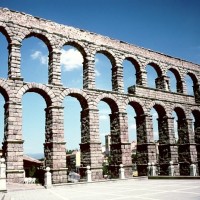 The Romans were not the inventors of water transportation, as primitive canals and other systems existed prior to Ancient Roman times. Nonetheless, they further advanced the concept and applied their engineering expertise to construct the Aqueduct. This was a significant and remarkable achievement, as it enabled the transportation of clean water from nearby streams into towns and cities. The Aqueducts had a profound impact, improving public health and providing a reliable water supply for various urban needs.
The Romans were not the inventors of water transportation, as primitive canals and other systems existed prior to Ancient Roman times. Nonetheless, they further advanced the concept and applied their engineering expertise to construct the Aqueduct. This was a significant and remarkable achievement, as it enabled the transportation of clean water from nearby streams into towns and cities. The Aqueducts had a profound impact, improving public health and providing a reliable water supply for various urban needs.
 The Romans were not the inventors of water transportation, as primitive canals and other systems existed prior to Ancient Roman times. Nonetheless, they further advanced the concept and applied their engineering expertise to construct the Aqueduct. This was a significant and remarkable achievement, as it enabled the transportation of clean water from nearby streams into towns and cities. The Aqueducts had a profound impact, improving public health and providing a reliable water supply for various urban needs.
The Romans were not the inventors of water transportation, as primitive canals and other systems existed prior to Ancient Roman times. Nonetheless, they further advanced the concept and applied their engineering expertise to construct the Aqueduct. This was a significant and remarkable achievement, as it enabled the transportation of clean water from nearby streams into towns and cities. The Aqueducts had a profound impact, improving public health and providing a reliable water supply for various urban needs.
4 Surgical Tools
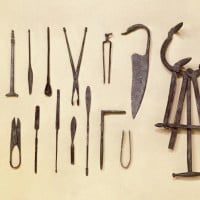 Given the frequent conflicts faced by the Romans, they had to devise methods to care for their soldiers, leading to the development of the first surgical tools. While the Greeks had made advancements in this domain, the Romans further expanded upon it by introducing numerous innovative surgical tools and techniques. These ancient tools served as the foundation for many of the surgical instruments used in modern times. In addition to their application in hospitals and medical centers, these tools were also utilized on the battlefield. Certain Roman armies employed skilled chirurgus, akin to modern-day field medics, who were responsible for stemming blood loss, extracting arrows, suturing wounds, and administering medication.
Given the frequent conflicts faced by the Romans, they had to devise methods to care for their soldiers, leading to the development of the first surgical tools. While the Greeks had made advancements in this domain, the Romans further expanded upon it by introducing numerous innovative surgical tools and techniques. These ancient tools served as the foundation for many of the surgical instruments used in modern times. In addition to their application in hospitals and medical centers, these tools were also utilized on the battlefield. Certain Roman armies employed skilled chirurgus, akin to modern-day field medics, who were responsible for stemming blood loss, extracting arrows, suturing wounds, and administering medication.
 Given the frequent conflicts faced by the Romans, they had to devise methods to care for their soldiers, leading to the development of the first surgical tools. While the Greeks had made advancements in this domain, the Romans further expanded upon it by introducing numerous innovative surgical tools and techniques. These ancient tools served as the foundation for many of the surgical instruments used in modern times. In addition to their application in hospitals and medical centers, these tools were also utilized on the battlefield. Certain Roman armies employed skilled chirurgus, akin to modern-day field medics, who were responsible for stemming blood loss, extracting arrows, suturing wounds, and administering medication.
Given the frequent conflicts faced by the Romans, they had to devise methods to care for their soldiers, leading to the development of the first surgical tools. While the Greeks had made advancements in this domain, the Romans further expanded upon it by introducing numerous innovative surgical tools and techniques. These ancient tools served as the foundation for many of the surgical instruments used in modern times. In addition to their application in hospitals and medical centers, these tools were also utilized on the battlefield. Certain Roman armies employed skilled chirurgus, akin to modern-day field medics, who were responsible for stemming blood loss, extracting arrows, suturing wounds, and administering medication.
5 Roman Numerals
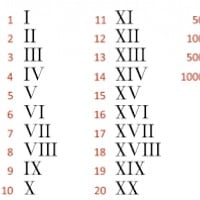 The system of Roman numerals represents numbers using combinations of letters from the Latin alphabet: I, V, X, L, C, D, and M. These symbols correspond to the numbers 1, 5, 10, 50, 100, 500, and 1000, respectively. Each number can be decomposed and expressed as a Roman numeral. However, in the 14th century, Roman numerals were replaced by Arabic numerals, which proved to be more efficient for arithmetic and counting purposes. Today, we still encounter the use of Roman numerals in various contexts, such as denoting book chapters or marking hours on clock faces.
The system of Roman numerals represents numbers using combinations of letters from the Latin alphabet: I, V, X, L, C, D, and M. These symbols correspond to the numbers 1, 5, 10, 50, 100, 500, and 1000, respectively. Each number can be decomposed and expressed as a Roman numeral. However, in the 14th century, Roman numerals were replaced by Arabic numerals, which proved to be more efficient for arithmetic and counting purposes. Today, we still encounter the use of Roman numerals in various contexts, such as denoting book chapters or marking hours on clock faces.
 The system of Roman numerals represents numbers using combinations of letters from the Latin alphabet: I, V, X, L, C, D, and M. These symbols correspond to the numbers 1, 5, 10, 50, 100, 500, and 1000, respectively. Each number can be decomposed and expressed as a Roman numeral. However, in the 14th century, Roman numerals were replaced by Arabic numerals, which proved to be more efficient for arithmetic and counting purposes. Today, we still encounter the use of Roman numerals in various contexts, such as denoting book chapters or marking hours on clock faces.
The system of Roman numerals represents numbers using combinations of letters from the Latin alphabet: I, V, X, L, C, D, and M. These symbols correspond to the numbers 1, 5, 10, 50, 100, 500, and 1000, respectively. Each number can be decomposed and expressed as a Roman numeral. However, in the 14th century, Roman numerals were replaced by Arabic numerals, which proved to be more efficient for arithmetic and counting purposes. Today, we still encounter the use of Roman numerals in various contexts, such as denoting book chapters or marking hours on clock faces. Since we use Hindu-Arabic numeral, so it is common. However, we also use roman numerals for some occasions. Both numeric systems gave a lot of influence.
6 Roads and Highways
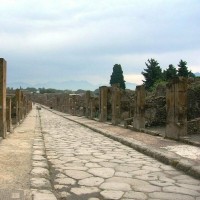 They say all roads lead to Rome, and the Romans indeed required an extensive road network to effectively govern their vast empire. They constructed an impressive 55,000 miles of roads across Europe and the Mediterranean region. These roads played a vital role in facilitating the transportation of essential supplies, deploying troops, and ensuring efficient communication throughout their territories, particularly during times of conflict and territorial expansion. The Romans were pioneers in implementing signs and markers along their roads, further enhancing navigation and providing valuable information to travelers along their well-organized and strategic road system.
They say all roads lead to Rome, and the Romans indeed required an extensive road network to effectively govern their vast empire. They constructed an impressive 55,000 miles of roads across Europe and the Mediterranean region. These roads played a vital role in facilitating the transportation of essential supplies, deploying troops, and ensuring efficient communication throughout their territories, particularly during times of conflict and territorial expansion. The Romans were pioneers in implementing signs and markers along their roads, further enhancing navigation and providing valuable information to travelers along their well-organized and strategic road system.
 They say all roads lead to Rome, and the Romans indeed required an extensive road network to effectively govern their vast empire. They constructed an impressive 55,000 miles of roads across Europe and the Mediterranean region. These roads played a vital role in facilitating the transportation of essential supplies, deploying troops, and ensuring efficient communication throughout their territories, particularly during times of conflict and territorial expansion. The Romans were pioneers in implementing signs and markers along their roads, further enhancing navigation and providing valuable information to travelers along their well-organized and strategic road system.
They say all roads lead to Rome, and the Romans indeed required an extensive road network to effectively govern their vast empire. They constructed an impressive 55,000 miles of roads across Europe and the Mediterranean region. These roads played a vital role in facilitating the transportation of essential supplies, deploying troops, and ensuring efficient communication throughout their territories, particularly during times of conflict and territorial expansion. The Romans were pioneers in implementing signs and markers along their roads, further enhancing navigation and providing valuable information to travelers along their well-organized and strategic road system.
7 The Postal System
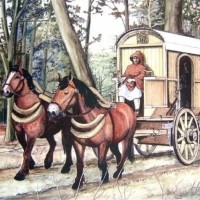 The development of the first postal and courier service can be attributed to Emperor Augustus around 20 B.C. This was a vital step due to the ever-expanding Roman Empire, which posed challenges in terms of communication and information dissemination. Known as the cursus publicus, this system facilitated the transfer of messages and notices between provinces with the aid of horses and vehicles like the horse cart known as rhedæ. Taking advantage of the well-established Roman road system, a mounted messenger could achieve an average speed of about 50 miles per day (80 km).
The development of the first postal and courier service can be attributed to Emperor Augustus around 20 B.C. This was a vital step due to the ever-expanding Roman Empire, which posed challenges in terms of communication and information dissemination. Known as the cursus publicus, this system facilitated the transfer of messages and notices between provinces with the aid of horses and vehicles like the horse cart known as rhedæ. Taking advantage of the well-established Roman road system, a mounted messenger could achieve an average speed of about 50 miles per day (80 km).
 The development of the first postal and courier service can be attributed to Emperor Augustus around 20 B.C. This was a vital step due to the ever-expanding Roman Empire, which posed challenges in terms of communication and information dissemination. Known as the cursus publicus, this system facilitated the transfer of messages and notices between provinces with the aid of horses and vehicles like the horse cart known as rhedæ. Taking advantage of the well-established Roman road system, a mounted messenger could achieve an average speed of about 50 miles per day (80 km).
The development of the first postal and courier service can be attributed to Emperor Augustus around 20 B.C. This was a vital step due to the ever-expanding Roman Empire, which posed challenges in terms of communication and information dissemination. Known as the cursus publicus, this system facilitated the transfer of messages and notices between provinces with the aid of horses and vehicles like the horse cart known as rhedæ. Taking advantage of the well-established Roman road system, a mounted messenger could achieve an average speed of about 50 miles per day (80 km).
8 Newspapers
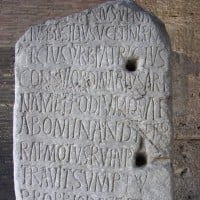 Romans were the first to distribute daily news to their citizens. Of course they did not use paper as a means of communication, instead they inscribed news of current affairs (political developments, military updates or details about major scandals or stories) unto stones, papyri, or metal slabs, which were placed in public spaces.
Romans were the first to distribute daily news to their citizens. Of course they did not use paper as a means of communication, instead they inscribed news of current affairs (political developments, military updates or details about major scandals or stories) unto stones, papyri, or metal slabs, which were placed in public spaces.
 Romans were the first to distribute daily news to their citizens. Of course they did not use paper as a means of communication, instead they inscribed news of current affairs (political developments, military updates or details about major scandals or stories) unto stones, papyri, or metal slabs, which were placed in public spaces.
Romans were the first to distribute daily news to their citizens. Of course they did not use paper as a means of communication, instead they inscribed news of current affairs (political developments, military updates or details about major scandals or stories) unto stones, papyri, or metal slabs, which were placed in public spaces. Not sure this quite counts as a newspaper but it's definitely an interesting development.
So the entire Flintstones "stone newspaper" joke was true?
9 Bound Books
 Bound books, known as codex, revolutionized document carrying by offering a collection of papyrus pages. Prior to this innovation, Romans would inscribe information on clay slabs and scrolls. The credit for the first bound book goes to Julius Caesar, who commissioned its creation. Bound books proved to be safer, more convenient, and equipped with a built-in protective cover. They also allowed for numbering, inclusion of a table of contents, and an index. Just imagine the impracticality of having a pile of clay slabs in your office - the bound book provided a much more practical and efficient solution.
Bound books, known as codex, revolutionized document carrying by offering a collection of papyrus pages. Prior to this innovation, Romans would inscribe information on clay slabs and scrolls. The credit for the first bound book goes to Julius Caesar, who commissioned its creation. Bound books proved to be safer, more convenient, and equipped with a built-in protective cover. They also allowed for numbering, inclusion of a table of contents, and an index. Just imagine the impracticality of having a pile of clay slabs in your office - the bound book provided a much more practical and efficient solution.
 Bound books, known as codex, revolutionized document carrying by offering a collection of papyrus pages. Prior to this innovation, Romans would inscribe information on clay slabs and scrolls. The credit for the first bound book goes to Julius Caesar, who commissioned its creation. Bound books proved to be safer, more convenient, and equipped with a built-in protective cover. They also allowed for numbering, inclusion of a table of contents, and an index. Just imagine the impracticality of having a pile of clay slabs in your office - the bound book provided a much more practical and efficient solution.
Bound books, known as codex, revolutionized document carrying by offering a collection of papyrus pages. Prior to this innovation, Romans would inscribe information on clay slabs and scrolls. The credit for the first bound book goes to Julius Caesar, who commissioned its creation. Bound books proved to be safer, more convenient, and equipped with a built-in protective cover. They also allowed for numbering, inclusion of a table of contents, and an index. Just imagine the impracticality of having a pile of clay slabs in your office - the bound book provided a much more practical and efficient solution.
10 Julian Calendar
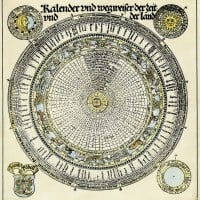 The Julian calendar, officially established by Julius Caesar in 46 B.C., was a 365-day calendar. It replaced a lunar cycle-based calendar that gradually became misaligned with the seasons. The Julian calendar remained in use until 1582 when the Gregorian calendar was introduced to account for the slight discrepancy in the length of a year, which is not precisely 365 and 1/4 days long. An interesting fact is that this calendar was named after Julius Caesar, as was the month of July itself.
The Julian calendar, officially established by Julius Caesar in 46 B.C., was a 365-day calendar. It replaced a lunar cycle-based calendar that gradually became misaligned with the seasons. The Julian calendar remained in use until 1582 when the Gregorian calendar was introduced to account for the slight discrepancy in the length of a year, which is not precisely 365 and 1/4 days long. An interesting fact is that this calendar was named after Julius Caesar, as was the month of July itself.
 The Julian calendar, officially established by Julius Caesar in 46 B.C., was a 365-day calendar. It replaced a lunar cycle-based calendar that gradually became misaligned with the seasons. The Julian calendar remained in use until 1582 when the Gregorian calendar was introduced to account for the slight discrepancy in the length of a year, which is not precisely 365 and 1/4 days long. An interesting fact is that this calendar was named after Julius Caesar, as was the month of July itself.
The Julian calendar, officially established by Julius Caesar in 46 B.C., was a 365-day calendar. It replaced a lunar cycle-based calendar that gradually became misaligned with the seasons. The Julian calendar remained in use until 1582 when the Gregorian calendar was introduced to account for the slight discrepancy in the length of a year, which is not precisely 365 and 1/4 days long. An interesting fact is that this calendar was named after Julius Caesar, as was the month of July itself.The Contenders
11 Corvus
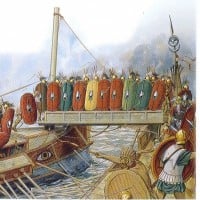 The corvus, an extraordinary naval invention by the Romans, served as a pivotal boarding device in intense sea battles. Acting as a versatile movable bridge, it featured a sturdy metal prong that could be skillfully deployed onto the deck of enemy Carthaginian ships. With this ingenious mechanism, Roman sailors gained a significant tactical advantage, swiftly and securely connecting their vessels to those of their adversaries. The corvus enabled Roman forces to unleash their formidable infantry troops directly onto the enemy's ship, leading to fierce hand-to-hand combat and turning the tide of maritime engagements. This inventive and effective device played a vital role in the Romans' naval prowess and strategic victories throughout their ancient empire.
The corvus, an extraordinary naval invention by the Romans, served as a pivotal boarding device in intense sea battles. Acting as a versatile movable bridge, it featured a sturdy metal prong that could be skillfully deployed onto the deck of enemy Carthaginian ships. With this ingenious mechanism, Roman sailors gained a significant tactical advantage, swiftly and securely connecting their vessels to those of their adversaries. The corvus enabled Roman forces to unleash their formidable infantry troops directly onto the enemy's ship, leading to fierce hand-to-hand combat and turning the tide of maritime engagements. This inventive and effective device played a vital role in the Romans' naval prowess and strategic victories throughout their ancient empire.
 The corvus, an extraordinary naval invention by the Romans, served as a pivotal boarding device in intense sea battles. Acting as a versatile movable bridge, it featured a sturdy metal prong that could be skillfully deployed onto the deck of enemy Carthaginian ships. With this ingenious mechanism, Roman sailors gained a significant tactical advantage, swiftly and securely connecting their vessels to those of their adversaries. The corvus enabled Roman forces to unleash their formidable infantry troops directly onto the enemy's ship, leading to fierce hand-to-hand combat and turning the tide of maritime engagements. This inventive and effective device played a vital role in the Romans' naval prowess and strategic victories throughout their ancient empire.
The corvus, an extraordinary naval invention by the Romans, served as a pivotal boarding device in intense sea battles. Acting as a versatile movable bridge, it featured a sturdy metal prong that could be skillfully deployed onto the deck of enemy Carthaginian ships. With this ingenious mechanism, Roman sailors gained a significant tactical advantage, swiftly and securely connecting their vessels to those of their adversaries. The corvus enabled Roman forces to unleash their formidable infantry troops directly onto the enemy's ship, leading to fierce hand-to-hand combat and turning the tide of maritime engagements. This inventive and effective device played a vital role in the Romans' naval prowess and strategic victories throughout their ancient empire. The Corvus was also known for turning the sea battles into land battles, done by anchoring Carthaginian ships whenever they were close to each other where infantry would battle enemies in the platform. This significantly helped the Romans win the First Punic War against the Carthaginians
12 Hypocaust System
 A hypocaust is a remarkable system of central heating in buildings, which generates and circulates hot air beneath the floor of a room, and sometimes also warms the walls through a network of pipes. The Romans employed this system in virtually all types of buildings, particularly houses and bathhouses. Its widespread use ensured comfortable and well-heated spaces, reflecting the Romans' advanced understanding of heating technology and their commitment to enhancing the comfort of their architectural structures.
A hypocaust is a remarkable system of central heating in buildings, which generates and circulates hot air beneath the floor of a room, and sometimes also warms the walls through a network of pipes. The Romans employed this system in virtually all types of buildings, particularly houses and bathhouses. Its widespread use ensured comfortable and well-heated spaces, reflecting the Romans' advanced understanding of heating technology and their commitment to enhancing the comfort of their architectural structures.
 A hypocaust is a remarkable system of central heating in buildings, which generates and circulates hot air beneath the floor of a room, and sometimes also warms the walls through a network of pipes. The Romans employed this system in virtually all types of buildings, particularly houses and bathhouses. Its widespread use ensured comfortable and well-heated spaces, reflecting the Romans' advanced understanding of heating technology and their commitment to enhancing the comfort of their architectural structures.
A hypocaust is a remarkable system of central heating in buildings, which generates and circulates hot air beneath the floor of a room, and sometimes also warms the walls through a network of pipes. The Romans employed this system in virtually all types of buildings, particularly houses and bathhouses. Its widespread use ensured comfortable and well-heated spaces, reflecting the Romans' advanced understanding of heating technology and their commitment to enhancing the comfort of their architectural structures.
13 Vending Machine
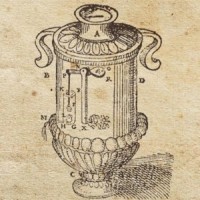 The earliest known reference to a vending machine can be found in the works of Hero of Alexandria, an engineer and mathematician from first-century Roman Egypt. Hero's machine was installed inside temples and designed to accept a coin, after which it would dispense holy water. Upon depositing the coin, it would fall onto a pan connected to a lever, triggering the dispensing mechanism.
The earliest known reference to a vending machine can be found in the works of Hero of Alexandria, an engineer and mathematician from first-century Roman Egypt. Hero's machine was installed inside temples and designed to accept a coin, after which it would dispense holy water. Upon depositing the coin, it would fall onto a pan connected to a lever, triggering the dispensing mechanism.
 The earliest known reference to a vending machine can be found in the works of Hero of Alexandria, an engineer and mathematician from first-century Roman Egypt. Hero's machine was installed inside temples and designed to accept a coin, after which it would dispense holy water. Upon depositing the coin, it would fall onto a pan connected to a lever, triggering the dispensing mechanism.
The earliest known reference to a vending machine can be found in the works of Hero of Alexandria, an engineer and mathematician from first-century Roman Egypt. Hero's machine was installed inside temples and designed to accept a coin, after which it would dispense holy water. Upon depositing the coin, it would fall onto a pan connected to a lever, triggering the dispensing mechanism.
14 Control Valves
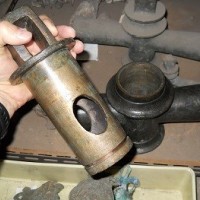 Since the Romans created aqueducts, it is evident that they needed a means to regulate the flow of water. As such, the Romans are credited with inventing the control valve.
Since the Romans created aqueducts, it is evident that they needed a means to regulate the flow of water. As such, the Romans are credited with inventing the control valve.
 Since the Romans created aqueducts, it is evident that they needed a means to regulate the flow of water. As such, the Romans are credited with inventing the control valve.
Since the Romans created aqueducts, it is evident that they needed a means to regulate the flow of water. As such, the Romans are credited with inventing the control valve.
15 Apartments
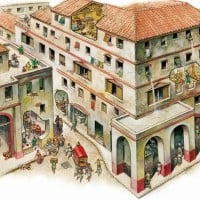 The insulae, typically comprising of six to eight apartment blocks constructed around a staircase and central courtyard, provided housing for impoverished workers who could not afford a conventional house. Landlords would rent out the ground floor units to shops, similar to contemporary apartment buildings. This notable arrangement makes Rome the earliest known urban society to adopt an apartment-based living system.
The insulae, typically comprising of six to eight apartment blocks constructed around a staircase and central courtyard, provided housing for impoverished workers who could not afford a conventional house. Landlords would rent out the ground floor units to shops, similar to contemporary apartment buildings. This notable arrangement makes Rome the earliest known urban society to adopt an apartment-based living system.
 The insulae, typically comprising of six to eight apartment blocks constructed around a staircase and central courtyard, provided housing for impoverished workers who could not afford a conventional house. Landlords would rent out the ground floor units to shops, similar to contemporary apartment buildings. This notable arrangement makes Rome the earliest known urban society to adopt an apartment-based living system.
The insulae, typically comprising of six to eight apartment blocks constructed around a staircase and central courtyard, provided housing for impoverished workers who could not afford a conventional house. Landlords would rent out the ground floor units to shops, similar to contemporary apartment buildings. This notable arrangement makes Rome the earliest known urban society to adopt an apartment-based living system.
16 Welfare
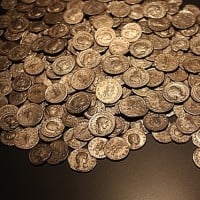 Historians assert that the earliest form of welfare can be traced back to ancient Rome. As an example, Emperor Augustus implemented the grain dole, a monthly provision of grain for those unable to afford food. It would take several decades before further developments and expansions were made to this concept.
Historians assert that the earliest form of welfare can be traced back to ancient Rome. As an example, Emperor Augustus implemented the grain dole, a monthly provision of grain for those unable to afford food. It would take several decades before further developments and expansions were made to this concept.
 Historians assert that the earliest form of welfare can be traced back to ancient Rome. As an example, Emperor Augustus implemented the grain dole, a monthly provision of grain for those unable to afford food. It would take several decades before further developments and expansions were made to this concept.
Historians assert that the earliest form of welfare can be traced back to ancient Rome. As an example, Emperor Augustus implemented the grain dole, a monthly provision of grain for those unable to afford food. It would take several decades before further developments and expansions were made to this concept.BAdd New Item